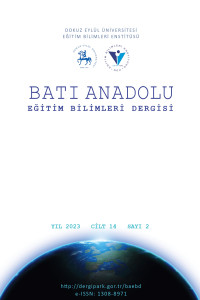Investigating the Differences & Similarities: A Comparison of Turkish and Pakistani Media Educational Systems
Abstract
This article is an attempt to compare the Pakistani and Turkish media educational systems with the view of revealing the similarities and differences between them. The novelty of the research lies in the fact that there are no previous studies attempted at examining and comparing Pakistan’s and Türkiye’s media educational systems. The study comprises 10 media faculties/departments of public sector universities from each country under study and applies descriptive content analysis to investigate the underpinned research subject through the websites and prospectuses of the faculties and/or departments. The present research lays out theoretical dimensions and statistics of Türkiye and Pakistan’s media educational systems, comparing and contrasting the statistical figures in terms of Ph.D and/or non-Ph.D faculty members, foreign Ph.D faculty members, male-female ratio, degree programs, facilities (campus radio station, TV station), publications, the ranking of the media faculties and departments. This comparative study aims at highlighting the gaps and proposing solutions for improving the quality of Pakistan’s media educational system, as media is an integral part of our society and it is the fourth estate.
Keywords
Pakistani’s media education Türkiye’s media education media education mass communication media studies communication studies
References
- AKGÜL, M., & AKDAĞ, M. (2017). Türkiye’de Yeni Medya Eğitimi Üzerine Niceliksel Bir Betimleme. Erciyes İletişim Dergisi, 5(1), 210–220.
- Arık, M. B., & Bayram, F. (2011). İletişim Eğitimi ve İletişim Akademisyenleri: Veriler Işığında Genel Bir Değerlendirme. Akdeniz Üniversitesi İletişim Fakültesi Dergisi, 15, 81–98.
- Ashraf, A., & Chaudhry, N. I. (2013). Media Education in Pakistan : Curricula, Facilities and Practices in Public Sector Universities. International Journal of Humanities and Social Science, 3(20), 184–197.
- Aslan, C. E. (2017). Türkiye’de İletişim Eğitiminin Başlangici: Uluslararasi Etkiler Açisindan Bir Değerlendirme. Ankara Üniversitesi.
- Dağtaş, E. (2003). Gazetecilik Eğitiminde Kuram ve Uygulama İkilemi: Türkiye’deki İletiþim Fakülteleri Üzerine Bir Araştırma. Gazi Üniversitesi iletişim Fakültesi İletişim Dergisi, 17, 143–200.
- Daniel, A. (1990). Public ratings of journalists in issues in Australia journalism (John Henni). Longman Cheshire.
- DİNÇER, Ö., BULUT, Ç. K., & ÇOMU, T. (2021). Türkiye’de Yükseköğretim Politikaları Bağlamında Gazetecilik. Türkiye İletişim Araştırmaları Dergisi, 37, 193–214. doi: 10.17829/turcom.861477
- Doğan, D. (2013). Yeni Kurulan Üniversitelerin Sorunları ve Çözüm Önerileri. Yüksekögretim ve Bilim Dergisi, 3(2), 108–116.
Abstract
This article is an attempt to compare the Pakistani and Turkish media educational systems with the view of revealing the similarities and differences between them. The novelty of the research lies in the fact that there are no previous studies attempted at examining and comparing Pakistan’s and Türkiye’s media educational systems. The study comprises 10 media faculties/departments of public sector universities from each country under study and applies descriptive content analysis to investigate the underpinned research subject through the websites and prospectuses of the faculties and/or departments. The present research lays out theoretical dimensions and statistics of Türkiye and Pakistan’s media educational systems, comparing and contrasting the statistical figures in terms of Ph.D and/or non-Ph.D faculty members, foreign Ph.D faculty members, male-female ratio, degree programs, facilities (campus radio station, TV station), publications, the ranking of the media faculties and departments. This comparative study aims at highlighting the gaps and proposing solutions for improving the quality of Pakistan’s media educational system, as media is an integral part of our society and it is the fourth estate.
Keywords
Pakistani’s Media Education Türkiye’s Media Education Media Education Mass Communication Media Studies Communication Studies
References
- AKGÜL, M., & AKDAĞ, M. (2017). Türkiye’de Yeni Medya Eğitimi Üzerine Niceliksel Bir Betimleme. Erciyes İletişim Dergisi, 5(1), 210–220.
- Arık, M. B., & Bayram, F. (2011). İletişim Eğitimi ve İletişim Akademisyenleri: Veriler Işığında Genel Bir Değerlendirme. Akdeniz Üniversitesi İletişim Fakültesi Dergisi, 15, 81–98.
- Ashraf, A., & Chaudhry, N. I. (2013). Media Education in Pakistan : Curricula, Facilities and Practices in Public Sector Universities. International Journal of Humanities and Social Science, 3(20), 184–197.
- Aslan, C. E. (2017). Türkiye’de İletişim Eğitiminin Başlangici: Uluslararasi Etkiler Açisindan Bir Değerlendirme. Ankara Üniversitesi.
- Dağtaş, E. (2003). Gazetecilik Eğitiminde Kuram ve Uygulama İkilemi: Türkiye’deki İletiþim Fakülteleri Üzerine Bir Araştırma. Gazi Üniversitesi iletişim Fakültesi İletişim Dergisi, 17, 143–200.
- Daniel, A. (1990). Public ratings of journalists in issues in Australia journalism (John Henni). Longman Cheshire.
- DİNÇER, Ö., BULUT, Ç. K., & ÇOMU, T. (2021). Türkiye’de Yükseköğretim Politikaları Bağlamında Gazetecilik. Türkiye İletişim Araştırmaları Dergisi, 37, 193–214. doi: 10.17829/turcom.861477
- Doğan, D. (2013). Yeni Kurulan Üniversitelerin Sorunları ve Çözüm Önerileri. Yüksekögretim ve Bilim Dergisi, 3(2), 108–116.
Details
| Primary Language | English |
|---|---|
| Subjects | Other Fields of Education, Social and Humanities Education (Excluding Economics, Business and Management) |
| Journal Section | Articles |
| Authors | |
| Early Pub Date | October 24, 2023 |
| Publication Date | December 28, 2023 |
| Submission Date | March 17, 2023 |
| Published in Issue | Year 2023 Volume: 14 Issue: 2 |


